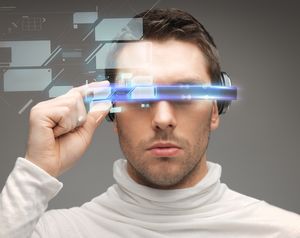KANBrief 1/18

Smart glasses at the workplace are no longer the stuff of science fiction. Hailed (or ridiculed) until quite recently as a futuristic project of the Californian tech scene, these devices have now found their way into warehousing workplaces and manufacturing and maintenance activities. Research into safe use of the devices is however lagging behind development of the technology itself, as is the body of regulations governing them and the associated requirements, which rely upon validated observations.
Smart glasses (also termed head mounted displays, HMDs) are head-mounted miniature computers. The wearer controls the device by gestures and speech; images are output on tiny monitors or prisms. These output devices are positioned either in front of one eye (monocular) or both (binocular). Smart glasses interact autonomously with their environment by means of sensors, and display context-specific information, such as the tightening torque of a threaded connection, in the wearer’s field of view. This augmented reality gives rise to new work scenarios.
“Pick by vision” refers to the use of smart glasses in order picking. The existing, widely used pick by voice systems, which convey information to employees by means of automated voice commands for the purpose of goods storage and retrieval, can now be replaced by information projected into the employee’s field of view. The information transmitted by the new systems is more complex, and the sensors on the devices document the process automatically. The workers‘ hands are kept free, and knowledge that was previously tied to the individual is transferred to the digitalized work system. Increases in productivity (work densification as a result of reduced idle times) and cost savings (the use of unskilled personnel made possible by technical assistance) that appear almost utopian are being reported from this area of activity. Should these reports prove well-founded, these devices will be adopted very rapidly.
Evident hazards associated with use of this new technology relate to distraction and general mental and physical stress. In research projects conducted in conjunction with the BGHW, the Institute for Occupational Safety and Health of the German Social Accident Insurance (IFA) is investigating the hazards associated with the wearing of smart glasses during the operation of industrial trucks. The issue of stresses upon the musculoskeletal system is also being examined, as is whether these devices offer potential for use for occupational safety and health purposes, for example during safety checks during the commissioning of complex machines.
The Federal Institute of Occupational Health (BAuA) is conducting laboratory and field studies into the effects of the technology and appropriate conditions for its use, and is publishing corresponding recommendations (Head-Mounted Displays – Arbeitshilfen der Zukunft. Bedingungen für den sicheren und ergonomischen Einsatz monokularer Systeme. BAuA, 2016). Issues concerning impairing neurological stress owing to display to only one eye, the implications of continual use over entire working shifts, and the consequences of impairing mental stresses caused by a lack of worker autonomy, densification of work and social isolation, are as yet unresolved.
The German Ordinance on workplaces (ArbStättV) formulates a clear requirement concerning the mobile use of new types of VDUs: devices that no longer distinguish between input device and screen “may be operated only at workplaces at which the devices are used only briefly, or at which the work tasks cannot be performed with the use of any other VDUs” (ArbStättV, Section 6.4, unofficial translation). Although the legislator may primarily have had tablet PCs in mind with this clause, smart glasses also satisfy the criteria stated and consequently must not be used continually – all the more so given that in most cases, the tasks in question can certainly be performed with the use of other, often more ergonomic tools. This issue requires explicit clarification and must also be addressed by OSH research activity.
Standards bodies are called upon to develop specifications in order to take account of the burgeoning device classes, and to define quality requirements for application of the technology. The “Industry 4.0” working committee – still in its infancy – of the DIN Ergonomics standards committee has set itself the task of addressing smart glasses.
One thing is for certain: compliance with the German Occupational Safety and Health Act (ArbSchG), which should be taken as a given, must be set out as an essential requirement. Work must be shaped first and foremost so as to be humane. However glamorous the new technology from Californian think-tanks may be, it must be made subordinate to this principle.
Dr Michael Bretschneider-Hagemes
(Head of the employees’ liaison officeat the KAN Secretariat)
bretschneider@kan.de